Bruce "Snake" Gabrielson

The Evolution of the Short Board
Bruce "Snake" Gabrielson
A Talk First Presented at the Atlantic Surfers Organization
Wildwood, NJ
September 14, 1996
Updated February, 2002
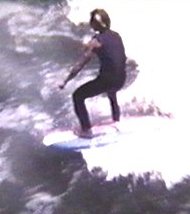
Introduction
My background in surfing goes back to the longboard years. I used to watch early day surfers at Long Beach in the mid-50s, but didn't regularly surf myself until I started about 1961 or so at the Power Plant in Seal Beach, California. I have surfed the West Coast from Oregon south, most of the East Coast, Puerto Rico, Australia, Hawaii, Mexico, Italy, and South America. I am also considered by the surfing world as the founder of organized high school surfing in California. Iíve been asked to describe my recollections of the shortboard evolution and how we got where we are today - I would like to thank a personal friend, Surfrider Board of Directors member, and Northern California surfer, Jim Lucas, who contributed to researching for this presentation. I would also like to thank Geoffrey McCormack and Drew Kampion for adding other bits and pieces to this effort.
Relevant Personal Board History
Before we start, I preface this talk by saying that boards for smaller kids were available even during the balsa era in the 6-7 ft range. What I'm going to discuss is my memories of of the emergence of the short board design. Shorter boards for larger people, not simply short longboards. Before I start, a little more relevant personal history. It's been a long time since these events took place, so I may be off on the dates or sizes exactly, but this is as close to accurate as I can recall after 30 years. I do, however, have dated film and pictures to validate some of this information.
I was a member of Surfboards Hawaii Surf Team riding a Surfboard's Hawaii Model A competition noserider that was 9' 4" in late 1965 (I was only about 120 lbs, but a 9'4" was considered very short in those days), still during the longboard era. I next went to Soul Surfboards as short boards started to come into their own and when Dale Velzy was their shaper - Dale taught me how to shape. I had a Soul shaped by Velsey after the US Championships in 1967, but it still had the traditional longboard design, even though it was about 8' 10".
Subsequently, I surfed for Petrillo and then Walden Surfboards until I opened Wave Trek in 1969, where I shaped and glassed boards until 1978. I think the next board, the Petrillo, was about 7' 6", and conformed to the newer (then) pintail short board designs. I believe we called this design the "Panatella" at the time. Therefore, in my mind, I think anything under about 8' 2" I'll start calling a traditional short board, and explain why later.
I began my personal memories by mentioning that starting about late 1968 I had two fairly regular Huntington Beach surfing partners, Charley (Chuck) Ray and often David Nuuhiwa. I owned a 1964 Ford Econoline van, by then the vehicle of choice for many surfers. Since I had the vehicle, I was the one who drove almost everywhere, and usually ended up having to drive back after a long day in the water. David, as you may know, was one of the top US surfers (at age 18), and some say the best in the world during this time. He was sponsored by Bing (the David Nuuhiwa Model) during the longboard era, before opening his YingYang shop near the pier about 1968. Charley and I were surfing for whoever we could find prior to Wave Trek, so were constantly looking for new designs and ideas.
 Why I mention our association with David is because during the late 1960s,
short board experiments started to get serious, and David was perhaps the
driver of the short board evolution in our part of Southern California. What David rode
strongly influenced the surfing world, and, by our association, also Charley
and I.
Why I mention our association with David is because during the late 1960s,
short board experiments started to get serious, and David was perhaps the
driver of the short board evolution in our part of Southern California. What David rode
strongly influenced the surfing world, and, by our association, also Charley
and I.
How The Evolution Started
Short boards didn't really happen overnight, although it seemed like it. I think a short board was anything under 8' 2", although some may argue that the 8' 6" mark is a closer dividing line. I say this because in the last days of the longboard era, at least two manufacturers, Surfboards Hawaii (Model A) and Greek (the Eliminator) were averaging 8' 4" to 9'8" for most competitor's models. Also, those selling the 8'6" board lines were still advertising that you had maneuverability, but could still walk to the nose. The "real" shortboard designs put major emphasis on carving and more radical turns. Some advertised that you could "turn from the middle of the board".
The shorter board design's didn't start to make an impact in big contests until late 1968, with the full short board evolution in place by summer, 1970.
After Nat Young won the World Championships in 1966 (many thought his 9'4" was a super shortboard since many people were on a 10' -11' boards), the Aussies went back to seriously redefine board lengths. The Aussie that designed the first thruster (tri-fin) was Simon Anderson. Other Aussie short board designers were Mark Richards, Simon Townsend, Ian (Kanga) Cairns, Tommy Carroll and some others. These guys were likely experimenting with short boards on the East Coast of Australia in the early to mid-1960s, it just took them awhile to figure out how to handle the short boards in bigger swells. The East Coast swells in Australia don't often get that big. On the other hand, the West Coast of Australia has plenty of big waves. Anderson tested his Thrusters back in the early 1970's on an island called Bali in Indonesia.
Corky Carroll's first mini-model was 8' 6" in 1967. Actually, Greek led the way around Huntington Beach with his first short (under 7') production boards showing up in mid-1968.
There were shorter and longboard riders competing against each other fairly frequently during this time. At the Santa Cruz Rivermouth contest Dale Dobson was the only finalist on a shorter board in '69. At the '68 World Championships in Puerto Rico, Hemings won on a longboard while the Aussies and Californians gagged big time on shortboards (even worse in '70 in Australia (World Chs) when most competitors were riding 5' 6" to 6' boards. Rolf Aurness was on a 6'10" single fin and won.
I remember one item about Corkey's competition boards. In the 1970 movie 5 Summer Stories, Corkey was still riding a board long enough that he could knee paddle it. That's why he was able to paddle around so easily and catch so many waves at the US Chs that year. That was the root of problems with short and longboards in the same heat. You could paddle around your competition quickly and catch lots of waves on longboards, especially in poorer quality surf, but you couldn't do as much on the wave with them. However, by paddling around to the inside, you could also prevent your competition from catching many waves due to the newly established interference rule that had gone into effect. Short boards thus had an effect on how contest were judged after 1970.
Among the leaders of the East Coast revolution was New Jersey surfing pioneer Roger Holden. Always a design innovator, one of Roger's earliest manufactured boards for Island East Surfboards in 1968 was a six+ foot, 30 inches wide square tail with a vee bottom and thin rails. This was perhaps the first "short" board design on the East Coast. Certainly it stood out at a time when most East Coast surfers were mostly thinking in terms of "nose rides" and 9 foot boards. Roger toured California that same year and his carving rail turns and quick cut backs also likely influenced many of the West Coast's top innovators of the time.
According to Northern California surfers Geoffrey McCormack and Jim Lucas, a shaper at O'Neills from Santa Cruz was an early short board innovator. Tom Hoye was aware of what the Aussies were doing, but believed more in the Hawaiian short board concept of Brewer and the MiniGun. A Hawaiian transplant, Keith Munro, brought two Brewer MiniGuns back when returning from a trip to see his parents. Keith also worked at O'Neills at the time. Hoye never shaped an Oz style short board. Shapers Joel Woods and Jim Foley were more into the full outline and deep V stuff of McTavish. When Hoye first began to shape shorter boards in late '68 (these boards were 7'10" to 8'2") the first comment most people had was "Can that thing float you?".
A 7' 10" board was shaped for Haut in 1968 with a sticker "For Pleasure Only". This was a blunt squaretail design with a raked fin, approaching the true short board designs starting to emerge, but not with the control necessary to handle bigger waves. The "For Pleasure Only" sticker was designed for and applied to longboard "Bump Decks" shaped by Doug Haut ala the "Harbour Cheater" at the end of the longboard era. They may have been applied to some shortboards but were never specifically a model.
The Huntington Fuse Ignites the Local Revolution
The local Huntington crowd was influenced by the shorter boards the Australians were riding, but something even more radical happened in the spring of 1968 that really set off the local revolution. The Huntington Beach Pier had a surfing regulation back then that forced board surfers out of the water at 11:00 am. Kneeboarders were allowed to stay in the outside break as long as they wanted. According to Chuck Ray, the legal length for a kneeboard was 4 ft 10 in.
That spring (68) the waves were true to form, about 4-5 ft with glassy shaped faces during the afternoon. Surfers were forced to sit on the beach and drool, watching the Kneeboarders, without much recourse.
 David Nuuhiwa had been thinking about short boards for some time.
One day the waves were very good, it was hot on the beach, and he got
frustrated watching kneeboarders having fun on the pier's south side.
He had an idea and went out to find a broken longboard, we had many around
the area due to pier action. The board was cut to 3 ft 11 in, and then had
a big fin glassed on. It looked sort of like the drawing at left.
A little while later he paddled out to surf with the
Kneeboarders. There must have been 20 top ranked surfers on the pier or the
beach watching when David caught that first wave, nearly all of whom went
nuts after the ride.
David Nuuhiwa had been thinking about short boards for some time.
One day the waves were very good, it was hot on the beach, and he got
frustrated watching kneeboarders having fun on the pier's south side.
He had an idea and went out to find a broken longboard, we had many around
the area due to pier action. The board was cut to 3 ft 11 in, and then had
a big fin glassed on. It looked sort of like the drawing at left.
A little while later he paddled out to surf with the
Kneeboarders. There must have been 20 top ranked surfers on the pier or the
beach watching when David caught that first wave, nearly all of whom went
nuts after the ride.
Within a couple of minutes, the lifeguards made David go in to have his board measured, then he was back out again for about a dozen more waves. The dye was cast for a serious shortboard revolution in Southern California.
The problem with David's original board was the fin broke off easily (it was mostly tacked on to an existing glass job) and the rail line went more down the middle then very low. To keep the board light it also had a rough glass job over the exposed foam and would ding easily. I should also mention that David's original short board was kept at the Wave Trek shop in Huntington as a curiosity until about 1976 when someone stole it
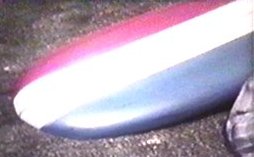 To take the idea further, a couple of weeks later Charley and I decided to make a more regular 4' 10"
short board from a full surfboard blank. He shaped and I glassed it.
We dropped the rail line on this new board so it would ride higher, widened and
thickened the nose, plus glassed on a slightly smaller but regularly installed fin.
The picture at the beginning
of this article is of Charley riding the Wave Trek "mini" board on the south side of the
pier.
This board was ridden, along with David's board at the Huntington Beach Pier for all to
see for some time after the initial ride, and helped reinforce the craze that was just
taking effect in southern California. Charley changed the design to make the board longer
soon after this first one.
To take the idea further, a couple of weeks later Charley and I decided to make a more regular 4' 10"
short board from a full surfboard blank. He shaped and I glassed it.
We dropped the rail line on this new board so it would ride higher, widened and
thickened the nose, plus glassed on a slightly smaller but regularly installed fin.
The picture at the beginning
of this article is of Charley riding the Wave Trek "mini" board on the south side of the
pier.
This board was ridden, along with David's board at the Huntington Beach Pier for all to
see for some time after the initial ride, and helped reinforce the craze that was just
taking effect in southern California. Charley changed the design to make the board longer
soon after this first one.
At the time we thought this might be a new craze we could make money on. The board wasn't fast and tended to ride high on waves, but it would catch almost anything and you could ride it with one foot on the nose. The best feature was that you could reach down and pull off kneeboarders when they took off in front of you.
I carried a movie camera around to film contests and other events as part of the regular surfing presentations I was making to schools back then, and just happen to have made an 8 mm film of Charley on this board. The film was made about a month after David's first ride. I believe it is the only footage in existence of a super short board ride during this early period of surfing's short board history.
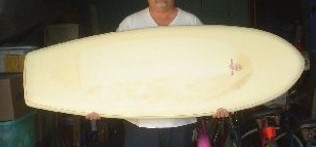 David subsequently had another regular after hours board made for himself. Shown in the figure at left,
This board and the Wave Trek board were the first two ridden at the HB Pier after surfing hours. The boards
were ridden primarily by David, myself, Charley Ray and LaRoy Dennis. David's first board was
lost for many years but finally found.
David subsequently had another regular after hours board made for himself. Shown in the figure at left,
This board and the Wave Trek board were the first two ridden at the HB Pier after surfing hours. The boards
were ridden primarily by David, myself, Charley Ray and LaRoy Dennis. David's first board was
lost for many years but finally found.
 About 2 weeks after David's first shortboard ride, there was big interest in a new board
down at the Frog House in Newport Beach. Someone had stripped a longboard
and reshaped it to about a 7' 6" pintail. At that time there were three
blank manufacturers, Clark, Walker, and newly formed Roger's. All blanks
being manufactured at that time were for longer boards. The blank represented a
big cost to shop owners,
most of whom made boards right on their premises (few environmental
restrictions like today). Therefore, reshaping represented a real big thing
as most shops were overloaded with old longboards (not the thinner new
concave nose variety) and the chance to remake an old longboard into a new
shortboard cheaply while getting rid of dead weight had tremendous appeal to
shop owners.
About 2 weeks after David's first shortboard ride, there was big interest in a new board
down at the Frog House in Newport Beach. Someone had stripped a longboard
and reshaped it to about a 7' 6" pintail. At that time there were three
blank manufacturers, Clark, Walker, and newly formed Roger's. All blanks
being manufactured at that time were for longer boards. The blank represented a
big cost to shop owners,
most of whom made boards right on their premises (few environmental
restrictions like today). Therefore, reshaping represented a real big thing
as most shops were overloaded with old longboards (not the thinner new
concave nose variety) and the chance to remake an old longboard into a new
shortboard cheaply while getting rid of dead weight had tremendous appeal to
shop owners.
Although there was a waiting list for those who wanted to try the board out, I was a friend of the Frog, so Charley and I got to try the board early on. I don't know who designed or made this ugly green board, but was told the reason for the pin tail was to overcome the loose tail problems with such a short board on larger waves. Island guns were pin tailed, so the reasoning was that the waves would be bigger for a short board, thus the stability problem would be solved.
Not long after the green board showed up, real short boards started to appear all over Southern California. One thing I should mention is that the Australians were leaning towards very thick boards to compensate for flotation at the time, but these lacked speed. The new Southern California designs had speed, but caught edges on flatter waves and didn't float well. Therefore, after the first wave of short boards, the next series were thicker and had slightly kicked noses to help with both flotation and to prevent purling.
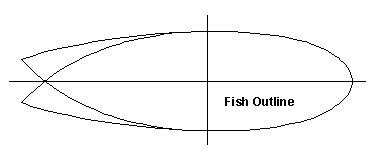 The Fish
The Fish
 The fish design, shown at left, is basically a double wrap of a template approaching
the outline of a fish. Several individuals now claim to have been involved in developing
different aspects of the Fish during different periods of time. However, I believe
David's version of a Fish was the first I saw during that period, and I was a regular
on the contest circuit at that time. David's first Fish type design was basically an
improvement of his super short board concept with low rails and the fish outline. He first
tried his design in early 1970.
The fish design, shown at left, is basically a double wrap of a template approaching
the outline of a fish. Several individuals now claim to have been involved in developing
different aspects of the Fish during different periods of time. However, I believe
David's version of a Fish was the first I saw during that period, and I was a regular
on the contest circuit at that time. David's first Fish type design was basically an
improvement of his super short board concept with low rails and the fish outline. He first
tried his design in early 1970.
Charley and I surfed with David when he rode his first fish type board and I happened to film both the board and him using it at Oak Street in Laguna Beach about a week after it was made. I believe that this film represents documented proof, not gossip that shows up in some magazine articles, that David had his own fish board type design rather then simply using anothers, as some seem to claim. Portions of this film were included on the CD produced for the Huntington Beach Surfing Association 30 year Reunion in 2000 and donated to the International Surfing Museum.
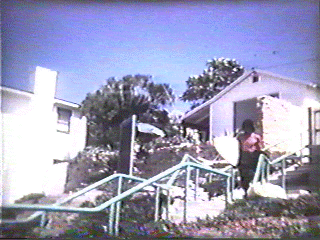
David Nuuhiwa with his first "Fish" type board
One point about David's very first fish type board is that it had a single fin. However, I don't know if there was ever a production version of this board since David was still trying to get the tail stability issue under control about that time. David's eventual production board had two fins.
Another similar Fish type board was being designed at the same time by Steve Lis, a widely known kneeboarder. Steve was working on his own similar "Fish" kneeboard model at that time which involved a twin fin approach. Steve lived in Pt. Loma. However, he regularly made surf trips up to Black's as well as the Sunset Cliffs area. Steve's eventual "Fish" was a split tailed, twin fin, ultra short but wide, shortboard. The Fish had a quick turning radius combined with very quick bursts of speed when slotted in the pocket of a wave. This board and David's board were eventually merged.
David rode this design to a 2nd place finish in the 1972 World Championships. I should also mention David's style was so smooth that he could ride a super short board much better than nearly everyone else.
 Big wave Shortboards
Big wave Shortboards
 The balsa "Pocket Rocket" built about 1971 or 72, is another example of this
early shortboard style. LaRoy Dennis (left)
and I made this board after LaRoy got
the idea from Reno Albelara in Hawaii. Reno was experimenting with short
boards on larger waves. The problem was that short foam boards didn't hold
well on big waves, especially in offshore wind. The balsa was much more
stable, but the poor flotation made the long paddle difficult. Not long
after this board was built, Reno started experimenting with a set of small
stick on fins for stability, and foam became the material of choice for
small boards in big surf not long afterwards.
The balsa "Pocket Rocket" built about 1971 or 72, is another example of this
early shortboard style. LaRoy Dennis (left)
and I made this board after LaRoy got
the idea from Reno Albelara in Hawaii. Reno was experimenting with short
boards on larger waves. The problem was that short foam boards didn't hold
well on big waves, especially in offshore wind. The balsa was much more
stable, but the poor flotation made the long paddle difficult. Not long
after this board was built, Reno started experimenting with a set of small
stick on fins for stability, and foam became the material of choice for
small boards in big surf not long afterwards.
Effect on Surfing's Society
At first there was serious resistance to the new short boards. The transition was not so easy, and the additional paddling and movement on the wave were at first considered a near term fad. A number of good surfers didn't transition, and ended up leaving the visible surfing world for several years afterwards. Also, not many of the older surfers would transition at first, causing a serious gender gap in the entire surfing community. Young hot-shot surfers simply could not identify with many of these older surfers, often creating confrontations when paddling for waves. When you combine the drastic board design changes with the fact that a great many surfers were away in the service during this evolutionary time, you can probably get a feel for the intensity and immediate reaction the coming of the short board had on the surfing world.
The biggest place where short boards had an instant effect was in contests. After the US Championships in 1969, nearly every top surfer was riding a shorter board, making it harder for some surfers to paddle around in poor surf while others could paddle easily and catch more waves. However, by 1970, nearly every contest surfer had transitioned to a mid-7 ft or shorter traditional short board design, or they had dropped out of competition. I previously mentioned that Corky Carroll was one of those contest surfers well adapt at fast paddling on his knees.
When Did it Take Effect
For a good date, I'm going to summarize by saying the short board evolution started about 1966 with the trend towards shorter length longboards. Both Walker and Clark were making lighter foam blanks then, and Roger's Foam came into the market about 1968 with a lighter blank as well. The trend towards shorted boards continued until 1969, when there was a drastic acceleration of the short board movement, culminating in very short designs by the mid to late-1970s.
Where Did it Go
From the pintail, we went to diamond, then rounded diamond, then square tail with knife edges as more surfers became used to the shorter design. Board size also dropped dramatically until a 5'4" twin fin square tail was very popular. I mention this particular design because I feel this may have been the beginning of the swing back towards longer designs used in the late 70s, 80's and 90's. Steve Walden made his first longboard - the concept of which was the beginning of the modern longboard design in 1973.
As blanks became lighter and sized to specific shorter designs, there evolved a myriad of custom shapes that suited nearly every style and need. Among those US shapers influential in templet, rail and fin designs were Dick Brewer, George Greenough, Mark Angle, Bob "The Greek" Bolen, and Bruce Jones. I should probably include LaRoy and myself on this list and am sure there are many more as well.
For very short board design, I think David (along with the San Diego kneeboarder Steve Lis) was probably one of the most influential of the progressive surfers in bringing in the short board. David's first Fish, shown in this film clip, effected both style and thinking for many of the best surfers and shapers of the time.
The first commercial tri-fins appearing about 1974 or 75 were basically single fin boards with plastic stick on edge fins. Surfing had been through a stage when contest and fun tricks like fin slipping and 360's caused board design to adjust for small, more looser tails with soft rails. The stick-ons (pioneered by Owl Chapman and mentioned earlier in this talk) were a way to control edges better without moving or changing fins around or getting two boards. The stick-ons were the forerunners of the thruster designs.

Return to Snake's Home Page